by B.B. Pelletier
Well, when was the last time we had a discussion this large on this blog? You were talking on yesterday’s report and on the first part of this series, all at the same time.
And, we were talking apples, oranges, cinnamon wafers and pseudo-dadaism in the post-war cinema! All at the same time.
So, once more, I will attempt to state what it is that we’re trying to do. We’re trying to discover some things that, if applied in certain ways, will always help improve accuracy. As I explained to several readers, the artillery hold is one such thing. I didn’t invent it. I just gave it a name so I could talk about it, and people would understand what I was talking about.
Now we’re looking for more things like the artillery hold that, if applied properly, will always improve your accuracy.
Today, you’re going to have to read the report very carefully, because the results you are about to see are the opposite of what you expect. But please read everything, and I’ll explain what I think has happened.
Yesterday, I tried using common reading glasses to improve the accuracy as I was shooting an Air Venturi Bronco rifle. I shot 6 groups of 10 shots each at targets 25 yards away. There were three pellets that I tested. Each pellet was shot first without me wearing reading glasses and then again with the glasses on. I showed you the targets as they occurred, and I told you after the shooting was finished that I could not discern any advantage to shooting with reading glasses.
Now I’ll show you what happened when I pre-sorted the pellets by weight before shooting. We’ll compare the best of the two targets shot yesterday with each pellet against a target shot with that same pellet sorted into a group of 10 pellets that weigh the same, down to the nearest tenth of a grain.
Those readers who do not have problems with their eyes can do today’s test as well by simply shooting two 10-shot groups — one with sorted pellets and one without.
Let’s begin
The first pellet shot was the same 8.4-grain JSB Exact domed pellet that I used to begin the test. I used that pellet because back when I tested the Bronco for you, it turned in the best results.
I weighed all the pellets on an electronic powder scale set to register grains. The scale weighs to the nearest tenth grain, so that was how I grouped them. Only those pellets that registered the exact same weight on this scale would be used.
Sorting the JSBs proved to be a big surprise for me, because they were not that uniform. Weights varied from 8.1 to 8.6 grains for a pellet that is nominally supposed to weigh 8.4 grains. I do appreciate that anything manmade will vary, but it has been my experience that premium pellets like these JSBs do not vary that much. But these did. In fact, I had to use the pellets that weighed 8.3 grains, because there weren’t enough of the ones that weighed 8.4 grains.

To get 10 pellets that weighed the same 8.3 grains, I rejected 26 others that varied from 8.1 to 8.6 grains.
Then, I shot the group. I took as much care as I had with all the other groups, plus these groups came after the first test, so I had 60 shots under my belt by this time. I expected to see a super-tight group.
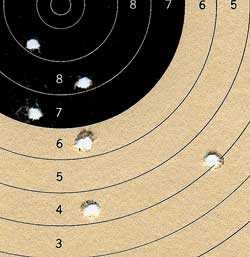
It looks like only 6 pellets went through, but the holes next to the numbers 7 and 6 on the target have multiple pellets through them. I can tell that from the back of the target paper. This group of pellets sorted by weight measures 2.061 inches between centers.
That group surprised me a lot, I can tell you. I expected a lot better performance from sorted pellets. Look at yesterday’s best group, shot with unsorted pellets.
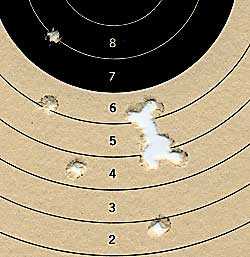
Ten shots with the same 8.4-grain JSB Exact pellet, only these were randomly selected from the tin. This group measures 2.085 inches between centers, which is only a trifle larger than the sorted group, above. These happened to be the ones shot while I was wearing reading glasses.
The next pellet to test was the BSA Wolverine. In sharp contrast to the JSB Exacts, above, these pellets were extremely consistent in weight, and I rejected only one while picking 10 to shoot.
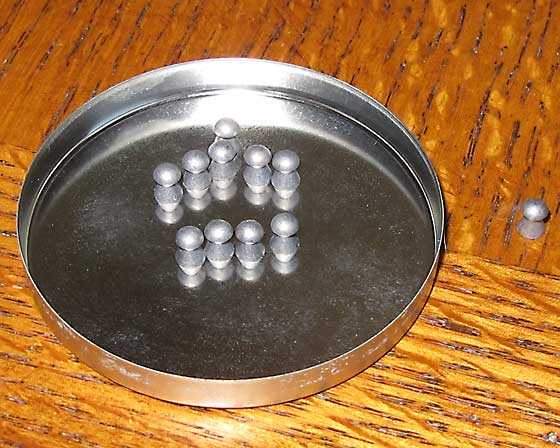
What a contrast! Only one pellet was found not to weigh 8.3 grains, and it weighed 8.2 grains. These pellets are extremely consistent in weight.
Well, I figured the consistent Wolverines were going to win the day, except they hadn’t been that accurate in the first two tests, and they should have been if weight variation matters to accuracy. And this time they were a real surprise!
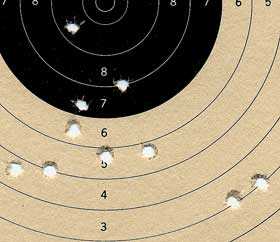
This group of 10 sorted BSA Wolverine pellets measures 2.481 inches on centers. It’s the worst group of the test (including all the shooting seen both yesterday and today).
I was really stumped, but please hang on because there’s an explanation coming. First, though, have a look at the best target shot with unsorted Wolverine pellets.
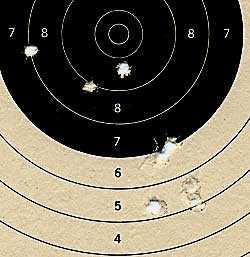
This Wolverine target shot yesterday without reading glasses measured 2.048 inches between centers. The target shot while wearing glasses measured the same size. Both are considerably smaller than today’s target shot with pellets sorted by weight.
The last pellet I tried was the RWS R-10 heavy pellet. I assumed that because it’s a target pellet it would be very uniform in weight. WRONG!
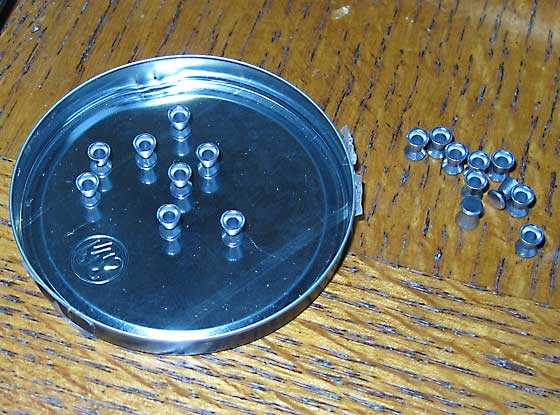
I had to weigh 18 RWS R-10 pellets to find 10 of the same weight. Those in the tin are the rejects, and they all weigh 8.1 grains. The pellets in the pile to the right weigh 8.2 grains.
And, you may remember that the R-10 pellets were by far the most accurate pellets of all in the first test. Well, this time they surprised me.
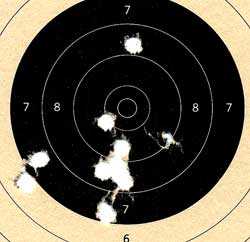
This group of sorted RWS R-10 pellets measures 1.743 inches between centers. It’s the largest group of R-10 fired. While the best group of the day, it’s larger than the random R-10s fired the day before.
Let’s look at the best R-10 group, fired during the first test.
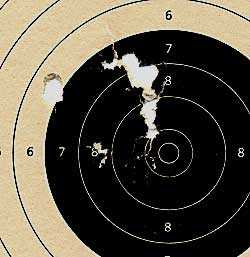
This group of R-10 pellets shot without reading glasses measures 1.158 inches between centers. Not only is it better than the group sorted by weight, it’s the best group of all the shooting done thus far.
Conclusions
Okay, here comes the explanation I promised. All these targets from yesterday and today were shot at the same time, so these three final targets shot with pellets sorted by weight were shot last. They represent shots 61 through 90.
I can’t prove it, but I believe that pellets of a uniform weight should not be less accurate than the same pellets of random weights. The results of today’s test seem to indicate that sorted pellets are less accurate than unsorted pellets if we go just by the group sizes, but I think something else is at work here. I believe there’s a whole lot of test bias in what I have reported both yesterday and today. I believe today’s results were skewed to the bad end of the scale because they were the last groups I shot and I was getting tired from all the sighting techniques I was undergoing to use the reading glasses.
As twotalon observed, are we talking about something so ambiguous that it will be different for every shooter? I don’t think so. But I do think that the test design I have done yesterday and today doesn’t work.
I believe the problem is lighting, as in not enough light on the target in these tests. I say that because today I went to the outdoor range and shot two 10-shot groups with a .30 caliber M1 Carbine at 50 yards and each group measured about three inches across the two widest shots. The M1 Carbine has a very large peep sight that has been criticized for its crudity, yet I shot well with it using the same reading glasses that failed in these tests. And, today I was able to see the bull quite well, even though it was twice as far away.
Finally, even out at 25 yards, the uniformity of pellet weight appears to not be much of a factor. The BSA Wolverines that were the most uniform weight did worst of all. Of course, the results of these tests are so large and open that all kinds of errors and truths may be camouflaged within.
Recommendations
From these two tests that I will have to consider as failed, we can draw some important conclusions. First, I need to either use a scope or a dot sight when conducting accuracy tests. Tomorrow, I’ll show you some groups that demonstrate that I can still shoot well with a scope.
Perhaps a future experiment might be for me to put a dot sight on the same Bronco and re-shoot this test. I’ll use the same three types of random pellets (not sorted by weight) for that test, then I’ll mount a scope on the rifle and shoot the same test again. If there’s a definite difference between the results from the two optical instruments (and I’m thinking there will be), I’ll select the most accurate optical sight and rerun the weight-sorted test.
Meanwhile, you can select as much of this test as you desire and try to do it yourself. When we’re finished, we should know the value of pellets sorted by weight and those of you who have old eyes like me might give the reading glasses trick a try, but only outdoors or where there’s a lot of light.

I FINALLY REALIZED WHAT IT IS.
This is like an old salty bar near the docks. A great place to hang out.
hoo-boy, I can’t wait for the responses to this.
To me this proves my feeling. You provide an invaluable service Tom…but results will always vary with individual users.
Science be damned (okay, I’ve got my tongue partially in my cheek here)…you can test all you want, but how an individual holds a gun…the lighting they are using…the tides of the ocean…all to me mean that though you (or anyone ‘testing’ a gun) is only going to give me an indication of what I can expect…it’s still up to me to sort out a gun to my particular set of user circumstances.
BB,
Thanks for the G.A.T. Part 3 effort. You have proven the human factor rules and fatigue is the culprit. Put that in the book – fatigue will cause larger groups, no matter what. That’s something the rest of us can be watching out for.
-Chuck
YAY!
What a relief it is to see the blog back up and running.
Absence makes the heart grow fonder.
This is going as smoothly as sighting in by dialing corrections after each shot.LOL Shooting can be a very humbling experience….at least for me.I was shocked at what I found when weighing a bunch of
boxed Crosman Premier .177 heavies last week.Maybe the weight difference has a varied effect depending on where on a pellet it occurs? Has anyone been able to quantify the velocity difference
in pellet groups after sorting them??We know it should be different,but is it exactly linear to the percentage of variance? I need to buy that chrony i keep puttin’ off ordering.
B.B.
This is a bit off the wall, and may or may not make a difference with some pellets…
Exactly how do these pellets fit when seated? Aside from head size.
For example with my Titan, most pellets had the skirt hang up and did not want to seat flush. My HWs are cut deeper and if the pellet is pushed flush the skirt is still loose. I can use a seating tool to push them a bit below flush where the skirt comes in full contact with the barrel and squares the pellet up.
Even though there is a bit of space to the back of the pellet, the back of the skirt is in full contact and square.
I have to wonder about consistency in velocity and possible skirt damage when firing when the pellet is not fitting right at the breech end.
twotalon
twotalon,
I wish I could remember how the pellets fit the bore, but I conducted this test last Tuesday, a week ago, and that wasn’t something I took note of.
B.B.
B.B.
Pellet weight.
When I tried sorting by weight I ran into all kinds of interesting things.
I used the WalrusWorld plastic storage boxes from the fishing tackle dept that had 5 or 6 compartments. With some tins there were not enough compartments. With other tins only once in a while there was not much point in sorting at all because they were so consistent (by weight).
By the time you sort through a tin, you can look at a general weight distribution from that tin by the heap of pellets in the different compartments. It can vary a lot from tin to tin.
twotalon
haha, twotalon you need a bigger tackle box!
Everyone,
This will be the last report of the Great Accuracy Test in the current format. Apparently there is too much information for many people, and also some folks do not like results that don’t finish well.
In short, I am boring many readers with too much detail. Also, the level of discussion required by this format seems to be daunting for some people. They are getting bored with it.
I will continue to conduct the test and you can follow along if you like, but in future reports I will merely condense the lessons learned (the bad things as well as the good things) into summary sentences and not report each step, like I have been until now.
For example, I already started the test suggested at the end of this report–the one where I test the differences between the precision of a dot sight and a scope, and I discovered that I cannot use a dot sight at 25 yards because of my eyes. So that test is now out.
Instead I will fast-forward to a test of weight-sorted pellets against random pellets using a scoped rifle of known accuracy.
B.B.
That’s sad, I liked this a lot and it seemed pretty straight foward to me.
Different people with different pellets and different rifles at different ranges.
Test 1 – 8 out of 12 people see improved accuracy doing “X”… Well it’s certainly worth a try for everyone else !!!
Test 2 – 3 out of 15 people see improved accuracy dong “Y”… NOT worth it!
Different people trying the same experiment with different equipment seemed to be the point of this test and seemed an easy way to test out some myths and maybe squeeze a little accuracy out of our rifles.
J-F
Sorry to hear this B.B., I for one am finding this very informative.
Real world results, real world conditions…and how to do better.
What more could anyone want (though admittedly I am probably one of the few who actually enjoy reading Yur Yev’s Competitive Shooting).
This is what I consider to be the most honest blog on shooting there is. I know that I’ve participated on a thread on the yellow the past couple of days on accuracy…basically a couple of us saying that we don’t really believe all the shooters claiming 1/4″ groups at 50yds with magnum springers. Of course we were in the minority because most over there, if you believe their claims can shoot multiple one holers at 100ft with any old gun off the Wallymart shelf.
I guess the shooters version of ‘the one that got away’.
Good to see we’re back.what happened?
BB ,I did my own test over the weekend using the iron (peep) sights and the reading glasses. I used a Crosman Quest .177 that I’ve had for several years. I have a Williams peep on the rear and I had modified the factory front ramp to take a Lyman #17 A front sight with replaceable apertures. I used the front sight insert with round apertures that matched the size of the target I used. The target was a NRA official 50 yard small bore rifle target. With little wind(rare here) and good light ,(outside and behind me), I got groups for ten shots that varied from 1.142 to 2.183 for the best and worst groups respectively, out of ten . That was for ten shot groups ,using UN-sorted H&N Finale Match .177 wad cutters, that were not the specific sorted head sizes. That pellet shoots the best in that gun, and I’ve got thousands of shots through it ,as I’ve modified the breech lock-up ,breech bolt , and barrel washers , trying to make it shoot like a better quality gun. Using the reading glasses ,which for me are only +1.50 , there was no difference ,except that I felt they fatigued me more while focusing on the front sight. I also shot off-hand at the paddles of my Devin Biathlon trap which are a little bigger than the bull on the 50 yard target(they are 4 3/8″), and could hit them every time,even though there is little light showing around the bull and the edges of the front aperture. So my conclusion was that I could shoot groups with the iron sights with my eye-sight, but that the target has to match the size of the front sight for the distance, and the lighting conditions. I need the reference of either a sliver of light around or at the bottom edge of the bull, or a spot of color on the front sight that contrasts with the target. So lighting conditions ,as you mention are probably the determining factor for me.
Robert,
Look at the next blog and you’ll see that the server went down. The blog is hosted on Amazon’s server in Virginia, and that outage hit a lot of sites.
Friday’s blog has been posted, and Monday’s will be posted early this afternoon. Then, it’s back to life as usual 🙂
Edith
Edith : Thanks, I was worried, need my fix (!) , but as the weather was so miserable here ,I couldn’t do my own accuracy test until yesterday afternoon. Too bad ,Tom has decided to scrap the idea for now.Take care, Robert.
Too bad , as you were really getting some good suggestions out in front of folks to test ,and see how they shoot as they do,and what if any benefit, conditions and equipment play in their personal progress. BTW, I also did my test above at the 25 yard distance outdoors.
Something I noticed in my shooting over the weekend – this isn’t in keeping with the above blog topic… but, I can see this subject come up sometime later on in this blog series.
While building up a ‘range card’ for my Benjamin Trail NP XL, I noticed something…
First off – I, personally, like to establish multiple zeros for the rifle, to reflect shooting at a variety of known distances…. I write the elevation changes for each distance in a small notebook — this is what I call my ‘range card’. I’m sure others have different names for this.
Anyways – I had a NCStar barrel-mount bi-pod…. but, I suspect that this particular bi-pod was meant more for airsofters than for people firing magnum powered nitro-piston rifles — as, the rifle literally shook the bi-pod apart…. most notably in the two legs of the bipod.
Because of this – I removed the bi-pod… swearing that the next bi-pod I get (if I get one) WILL be a Harris; as I know those are built to last.
Anyways – with that said: I notice this morning as I was doing some target shooting…. that the zeros have shifted…. not only that – from what I can tell so far (I haven’t the time this morning to test this yet), the trajectory of the pellet has also changed based on the changes I had to make to consistently place the shot on target.
I know a lot of folks like to have accesorries on their rifles and pistols…. I haven’t quite gotten to that point, but would like to add a few things over time…
However – how much of an effect does mounting accessories factor into changes to zero, changes to trajectory… and, to changes in overall accuracy in general? Also – how about the placement of these accessories? (aftermarket picatanny rails, barrel mounted, scope mounted, etc.)
This might be something interesting to look into in the future….
Wulfraed,
Back in the 1990s Tom Gore made adjustable muzzle brakes similar to the BOSS and the one I tested on a Webley Patriot did show that it was possible to tune barrel vibrations. The Whiscombe rifles also had an optional system known as the Harmonic Optimized Tuning System or HOTS. It was the same idea of moving a weight on the barrel in and out until best accuracy was achieved.
B.B.
Also, if you have a floating barrel, anything that doesn’t touch it shouldn’t affect accuracy, don’t you think?
-Chuck
Wow – I never knew they had such a system. Thanks for the great info! 🙂
Karsten,
Every time I switch to a bipod my zero changes. Same with switching back. Think vibration patterns and where the nodes move to when they change.
If your rifle barrel was a guitar string and you started pressing the fourth fret instead of the second one you would expect to hear a different note. It’s the same with a rifle barrel.
And ESPECIALLY if the bipod was mounted ON the barrel!
B.B.
Thanks “B.B.” (Sorry, I don’t know your real name),
That was very much what I suspected. I was wondering, not only in my case – which was with a barrel-mounted bi-pod, but what about other accessories…. The addition of equipment onto a shooting platform changes the balance-point for sure — but, I wonder if it has other; albiet subtle, effects on the rifle’s shooting characteristics… not neccesarily a deteriation in accuracy – but, rather, a shift in accuracy….
Karsten,
My name is Tom Gaylord.
Other accessories may change the vibration patterns, but it’s a sort of Heisenberg Principle thing. In other words, the rifle may shoot to a different point of aim without the scope, but how would I know it?
B.B.
Thanks for the reply again – Tom!
LOL – Yes, you would have to some of aiming device on the rifle… 🙂
When I mention accesories – I was talking about such things as bi-pods, lasers, flashlights, night vision, etc….
Great reply – I’m still chuckling to myself… 🙂
karsten,
By all means, check to see to make sure the brass brush will come completely out of the breach before starting the return stroke. It is nearly impossible to pull back on the rod if the brush is still in the barrel. A worn brush will reverse but a new one will require a vice and a strong buddy to get it back out.
-Chuck
Oops! This was meant for geekedout. Sorry karsten.
-Chuck
hee hee – no problem, Chuck….. I have admit – you had me scratching my head for a moment! LOL 🙂
karston.
I may be going out on a limb here but I think a gas piston powerplant is still subject to the same physical rules as a spring powered one except the effects may not be as harsh. This means that you still need to use the artillery hold. You can’t use an artillery hold with a bi-pod. I think this is another reason you are having a zero change.
Somone feel free to debunk me if I’m off base here.
-Chuck
Hi Chuck!
About 95% of my shooting is done without the aid of the bi-pod, in fact – of all my shooting; I do so in an unsupported position, mostly kneeling unsupported and off-hand… now that spring is here more in earnest (I live in Wisconsin), I will probably spend more time in prone position…. but, again – It will be in the unsupported prone.
The main reason why I got the bi-pod, is when I want to get a very nice steady hold of the rifle…. with a bi-pod, there is virtually no wobble or wandering, like you would in any other shooting situation.
I do use an artillery hold… maybe not the flat-palm platform that I see many competitive shooters use… I, basically, create a V-shaped notch between my thumb and my fingers, and that notch is where my rifle rests. The only pressure I use on the side of the forestock is to make sure that the rifle and scope is level…. there is no ‘gripping’.
With all that said: I can only speak from my experience – but, I’ve had good luck with shooting from a bi-pod…. it still takes some patience and focus – but, getting one-hole shots out to 60 meters wasn’t out of the question. I probably could make those shots at further distances – but, I’ve never tried. Without the bi-pod – the same shots can be done… but, it takes more concentration and focus.
I’m not debunking anything – just explaining my experience… others may have very different points of view on this matter…
karsten.
I would say go with what works best for you. In this case, your bi-pod is, so how can one argue with that? 🙂 Many rifles seem to prefer something different from the rest (hey is that a pun?). Sounds like you’ve got a really good one that shoots one-holers at 60m.
-Chuck
Thanks Chuck — unfortunately, it also likes to destroy cheap bi-pods too… 🙂
Mind you — the 60meter shots took the max magnification on my scope (a 3x – 9x)… and LOTS of focus and concentration. I would estimate that it would take me anywhere from a minute, to almost two minutes just to get one shot out. (get settled in, relax, get breathing in check, re-check my hold, adjust, relax.. then fire.)
🙂
karsten,
What are you talking about? I thought all shots were to be taken that way. Only John Wayne can shoot from the hip. Well, him and a guy I saw on youtube.
-Chuck
Hehe – I’m just saying… when I try for these precision shots. I REALLY take my time – if I’m not absolutely comfortable, and absolutely confident with the shot — I won’t take it.
There ain’t no COD-style 360 degree quick-scoping with me! 🙂
Can’t say that I have…. I’ve never tried archery…. never really gave it much thought, to be honest… I’ll look into it when I have time. Thanks for the suggestion. 🙂
One thing I have wondered about is weight distribution in a pellet, you could have two weigh the same but one could be heavier on one side. I worked for years as a balancer on fan rotors and this is what affected the vibration when it was spinning not the overall weight. I wold think this could cause it to spiral times velocity to a different POI for each pellet. Just a thought.
Shaky,
And a good thought. What would you do about it?
B.B.
Absolutely certain that an unbalanced pellet will precess. This will cause unpredictable (without a supercomputer of enormous power) motion through the air, as the spinning and precessing put forces on the pellet (think curve ball pitches). What I would likely do about it is buy better pellets…
Were it not for aerodynamic effects, the pellet probably would not move much off course, if at all.
People can say anything they want, but I believe a fixed barrel, not a break barrel rifle is the way to go with pellet rifles. Especially using scopes. For instance I get .198″ ctc from my Air Arms TX 200 fixed barrel at 26 ft. Crosman Premier heavies .177 cal. pellets. And that is mainly due to my heartbeat. Compared to .813 with my break barrel Benj. Trail. .22 cal, H&N pellets. That’s with weight sorted pellets. 10 shot groups. I can’t believe some of the things I found. For instance, I measured pellets from one tin of H&N pellets the spread was 11.97 – 12.26 grains. I measured each pellet of a 200 ct. tin. Won’t get into the statistics. But I remembered from a previous tin, the weights were heavier. Luckily i had some pellets remaining and measured those. The spread was 12.36 – 12.80 grains. I thought something might have been wrong the scale so I went back and reweighed some pellets from the first tin and the scale was right. Crimenently there wasn’t even any overlap between the two tins. And on the tin, it says the pellets are 12.65 grains. Crimenently, you would think that if they advertise weight to the second decimal point that they would be fairly close and consistent. Just proves, you gotta do the math. I bought a machinist’s dial indicator from Harbor Freight for $12 and a magnetic mount for $10. I ground the tip flat on the dial indicator and measured the different dimensions by placing the pellet between a flat plate and the flat tip of the dial indicator. I did that. The biggest difference was with the head of the pellet. The diameter was about .003-.004″ greater with the heavier pellets. The skirt and overal height were not as different. The skirt and height was about .001″ great with the heavier pellets. I am talking about the same pellet, just different tins. Still some more work to do. I did weigh sort some Daisy Premium Wadcutters and the ctc spread was .468″.. pretty good for the Benjamin Trail.
I also recollect the heaveir H&N were more accurate That is why I ordered three more tins and with the fourth tin free from Pyramyd I got four tins which looked like they were from the same sleeve which is a good thing but they’er all light ones. I am somewhat dissapointed that now these pellets don’t shoot as well. It is not the seller’s fault. It is the manufactureres fault.
So far this tells me both the weight and fit count. I believe that if the pellets does not fit right things like blow-by, the spining due to the rifling changes, friction and even exit effects are what throws off the accuracy.
Bruce, that’s apples and orangutans… if you pit a TX200 against a Benji Trail you are comparing a LOT more than just fixed vs. break-barrel.
Your Benji’s group of over 3/4″ at less than 10 yards is pretty bad and likely indicative of a poor shooting gun (or one that’s hard to shoot) rather than any compromises inherent in the breakbarrel design. The accuracy I get from my breakbarrel HW30 is comparable to what you’re seeing with your TX. I suspect that the quality of the barrels is pretty comparable between your TX and my HW, I wouldn’t bet a nickle that the same holds true for the Trail.
Well, there is still a lot of work to do. This is part of what we are trying to do. Let people voice their opinions and also for people to contribute things from what they have found with their own guns, pellets etc. The more information on this the better conclusions we can form. I don’t expect the Benj to perform as well as the TX, but I am still trying to determine what I can do to improve it. It’s fun to do these things. Heck, it’s no fun with the TX.
Bruce,
You have suggested a test of sorts. Pitting a fixed barrel against a breakbarrel. Now my Whiscombe JW 75 is a breakbarrel, so would that qualify?
B.B.
Sure, just post your results. Or take a breakbarrel that has both a scope and front and rear iron sights both on the barrel. I can’t do this because of my eyes but maybe someone else could. I may have come to hasty conclusion. That’s what these tests are all about.
Bruce, your results with your XL Trail at 10 yards exactly match mine BEFORE I did some crown work. I managed to half that group. The modification is very simple. Go here:
/blog//?s=re+crowning&search=Search
I managed to shoot a best of .415″ with H & N’s and am sure I can do even better now.
Fred PRoNJ
ok thanks Fred I’ll try that. I remember doing that to my Baikal 53M pistol as I had noticed a small burr there.
I also slightly chamfered and polished the end where the pellet goes in as to not scrape the pellet.
That’s a good move. Too sharp of an edge at the breech end snags and gouges pellets. It can also make seating pellets hard, and can lead to deforming the skirt from excessive pressure needed to seat them.
twotalon
OMG Fred, I see what you mean. On one side of the crown it looked fine as if the reamer the manufacture used was doing a good job of cutting. Then on the other side it was smeared and smeared over the rifles. You know, when I took the shroud off there was a bunch of little filings on the muzzle. I thought, where the heck are these coming from. Well the smeared ridge is shaving the pellets on every shot. Thanks for the link you provided about taking off the shroud and doing some crown work.
Bruce
Bruce,
How about a report after you recrown your barrel? I’d like to hear the results.
B.B.
Well I just got through shooting. I fired five preshots just out of the tin. Four had ctc of .313 and one outside and including that ctc became .468. Then shot 10 shot group with weigh sorted pellets ctc .592 with most having ctc .343. And all of the shots connected just four out at the ends forming a box. Really nice spread not anymore horizontally or verticle. I think some of that was me. But in doing the crown work I had to clean the barrel by just using rem oiled patches. The barrel seemed pretty dirty. So I am not so sure how much was due to the cleaning and how much was do to the crowning. Time will tell. But as far as I am concerned , I’m a happy camper. I know what can be done to comfortably hunt with my Benj. Trail. I did not have that feeling before.
Bruce
Bruce,
you are a real fast worker! Those results are on par with what I got, too. Let’s see if we can tighten those groups up even more. I’ll be back.
Fred PRoNJ
AS WOULD I! Bruce, for my next trip, I will probably order a glass bedding kit and bed the action into the stock. I’ll do a report on that. You know, it’s really a shame that Crosman isn’t exercising a bit more QC on this Chinese made rifle. It really could be a great rifle right out of the box rather than a “kit” rifle.
Hey Crosman, anyone working on a revised trigger like the one in the Marauder or even the Discovery, that will fit in this rifle?
Fred PRoNJ
This is off subject but with the 150th anniversary of the Civil War, if anyone would like to see what a Sergeant looked like in the Ohio Volunteer Infantry, I’ve posted a photo of the original photo my Mom has of my Great Great Grandpa Jason Brown, Fuller’s Ohio Brigade, 43rd OVI, Company G. Just go to Ohiocivilwar.org and search Jason Brown. Notice his Enfield rifle with fixed bayonet, Hardee Hat (pinned both sides), bugle signifying infantry, Sergeant’s chevrons and NCO’s sword.
Bruce,
Went there and saw your Great Great Grandfather. Super image! You have every right to be proud.
B.B.
More shooting with my newly crown worked Benj Trail. Crosman Premier Round Nose: 14.20 +- .02 grains, 10 shot group .468″ ctc, 14.30+-.02 grains ten shot group .405″ ctc. The Crosman Premier Round Nose seemed to be a little tighter fit than the H&N Hollow Points but as I mentioned in a previous post The H&N were way light, 12.08 grains versus the advertised weight of 12.65 grains. All shots at 26 ft. That’s all I have to work with.
Bruce
Bruce,
for 10 shots, that’s a pretty darn good group. Have you changed the trigger? I can’t remember if you did. I ordered a Charlie the Tuna GRT trigger which gave me some improvement over stock but it’s still a pp trigger design. However, I intend to glass bed this rifle and do a blog on it to see if we can’t improve the group even more. But a .405″ group for 10 pellets is getting into PCP territory I think.
Fred PRoNJ
No, I never changed the trigger. It’s gotten fairly smooth now. I must admit that it was pretty bad at first. I also did my crown work by hand. Before the work, my crown was worse than yours. I think. Fortunately, I had a dremel tool that was about 3/8″ dia like a wrecking ball and I had never used it before. It took a while but I turned it by hand until I could see each rifle land cleanly exposed by the same amount clear around the crown. Then I polished it by oil and metal polishing compound. My polishing compound had turned hard as a brick as it is about 34 years old and I hadn’t used it before. Was in the dremel tool kit. but with oil and turning the stone I managed to get some on the stone. I never did use the electric dremel motor. I was afraid it would get out of control. The 3/8″ dia stone is ruined now as it is pretty grooved now. But hey, I can always buy another.
Bruce
Bruce…
I am afraid that you are right about fixed barrels being more accurate than break barrels. My RR shoots better on the average than your Trail did, and at a bit more distance.
That was a fact, but let’s get real….
Don’t compare only one rifle against only one other rifle to develop a conclusion. You see such things done on other airgun forums and too many people take it as gospel.
You can deliberately or accidentaly rig a test to arrive at any conclusion you want.
Breakbarrels? I have been shooting my R7 in the basement due to bad weather. I only have a foot and a half short of 10 yds to work with. When I get bored with shooting paper, I stand pellets on top of the trap and shoot them off. Been using cplhp for both targets and ammo. Not he best, but I have a lot of them. I don’t think my B3 can beat that.
twotalon
Hercules B4-2 Crosman Premier Round Nose 14.14 +- .02 grains 10 shot group .718 ctc. Not bad for a $19 rifle. It still smokes, literally, once in a while after all these years. Had to loctite rinkydink scope rail, may have to drill and tap back rail clip to receiver. Actually has a very descent looking crown.
Bruce
BTW, that group just posted did have a couple of smokers.
Bruce
RWS Diana 48 Crosman Premier Round Nose 14.30+-.02 grains 10 shot group .155 ctc. Nice everything!
Unfortunately, even the rabbits are still safe from me, much less a small squirrel.
Granted, the 25yd range is a pistol range, so the benches weren’t conducive to any repeatable rest.
That, and I had six scopes rifles to sight in in six hours (of which, I think, only 30 minutes per hour was open for shooting). The rifle the rabbits need to be afraid of is the Browning A-Bolt Varmint model in .308Win, at 50 yard… Of course, the terrain won’t look too pretty with blood&guts splattered all over. I got that nearly zeroed in the last shooting session of the day — about 11-13 rounds into a ragged hold about 1.5×1.0″ centered about a half inch high (USA brand 7.62 FMJ)
The hardest rifle to sight in turned out to be the Ruger 77/17 (.17HMR)… I had four targets with Shoot-N-C sticker covering the bulls… and went through a box of 50 rounds without hitting a single one. And couldn’t see the impacts in the spotting scope either. Tried walking all over the target paper but apparently thought the problem was vertical setting… Switched to one large styrofoam target (the foam apparently cuts cleaner) — three shots aimed dead center, and the spotting scope showed a 3/4″ group a half inch low and two inches left.
For distances, I was setting the Gamo NRA 1000 .177 and RWS M54 .22 on the 25 yard range, Condor .22 and Marauder .177 on 50 yard — and had hoped to get the powder burners to the 100 yard but ran out of time.
Unfortunately, range safety rules are such that even with the air pump I would be unable to recharge the Maurauder… and I ran it nearly 500PSI below my test limit (a chronograph cycle showed the factory settings were best between 2700-2200, I drained it to 1700 so my scope adjustments are likely a bit off at the end.
So don’t expect any 25yard accuracy result from me — I still need to reliable hit the black. (The M54 seems a bit more conducive, even with the creepy trigger release).
I should add that the mandatory hearing and eye protection didn’t help… (My shooting inserts are distance prescription, making it nearly impossible to read the directions on the scope turrets)…
Try getting a good sight alignment when a bloody ear-muff is bonking against the stock…